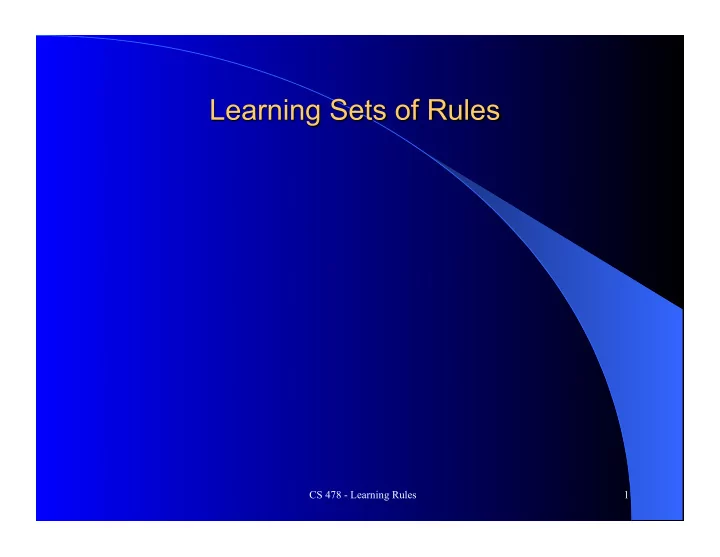

CS 478 - Learning Rules 1
If (Color = Red) and (Shape = round) then Class is A If (Color = Blue) and (Size = large) then Class is B If (Shape = square) then Class is A Natural and intuitive hypotheses – Comprehensibility - Easy to understand? CS 478 - Learning Rules 2
If (Color = Red) and (Shape = round) then Class is A If (Color = Blue) and (Size = large) then Class is B If (Shape = square) then Class is A Natural and intuitive hypotheses – Comprehensibility - Easy to understand? Ordered (Prioritized) rules - default at the bottom, common but not so easy to comprehend Unordered rules – Theoretically easier to understand, except must – Force consistency, or – Create a separate unordered list for each output class and use a tie- break scheme when multiple lists are matched CS 478 - Learning Rules 3
There are a number of rule learning algorithms based on different variations of sequential covering CN2, AQx, etc. – 1. Find a “good” rule for the current training set 2. Delete covered instances (or those covered correctly) from the training set 3. Go back to 1 until the training set is empty or until no more “good” rules can be found CS 478 - Learning Rules 4
The large majority of instances covered by the rule infer the same output class Rule covers as many instances as possible (general vs specific rules) Rule covers enough instances (statistically significant) Example rules and approaches? How to find good rules efficiently? - General to specific search is common Continuous features - some type of ranges/discretization CS 478 - Learning Rules 5
Relative frequency: n c / n n c + mp m -estimate of accuracy (better when n is small): n + m where p is the prior probability of a random instance having the output class of the proposed rule, penalizes rules with small n , Laplacian common: ( n c +1 ) /(n+|C| ) (i.e. m = 1/ p c ) Entropy - Favors rules which cover a large number of examples from a single class, and few from others | C | ∑ − p i log 2 p i – Entropy can be better than relative frequency i = 1 – Improves consequent rule induction. R1:(.7,.1,.1,.1) R2 (.7,0.3,0) - entropy selects R2 which makes for better subsequent specializations during later rule growth – Empirically, rules of low entropy have higher significance than relative frequency, but Laplacian often better than entropy CS 478 - Learning Rules 6
CS 478 - Learning Rules 7
CS 478 - Learning Rules 8
CS 478 - Learning Rules 9
Inductive Logic Programming Propositional vs. first order rules – 1st order allows variables in rules – If Color of object1 = x and Color of object 2 = x then Class is A – More expressive FOIL - Uses a sequential covering approach from general to specific which allows the addition of literals with variables CS 478 - Learning Rules 10
CS 478 - Learning Rules 11
CS 478 - Learning Rules 12
Typically would like focused exception rules higher and more general rules lower in the list Typical (CN2): Delete all instances covered by a rule during learning – Putting new rule on the bottom (i.e. early learned rules stay on top) makes sense since this rule is rated good only after removing all instances covered by previous rules, (i.e. instances which can get by the earlier rules). – Still should get exceptions up top and general rules lower in the list because exceptions will achieve a higher score and thus be added first (assuming statistical significance) than a general rule which has to cover more cases. Even though E keeps getting diminished there should still be enough data to support reasonable general rules later (in fact the general rules should get increasing scores after true exceptions are removed). Highest scoring rules: Somewhat specific, high accuracy, sufficient coverage Medium scoring rules: General and specific with reasonable accuracy and coverage Low scoring rules: Specific with low coverage, and general with low accuracy 13
If delete only correct instances covered by a rule – Putting new rule on the the top (i.e. first learned rule stays on bottom) could make sense because we could learn exception rules for those instances not covered by general rules at the bottom – This only works if the rule placed at the bottom is truly more general than the later rules (i.e. many novel instances will slide past the more exceptional rules and get covered by the general rules at the bottom) Sort after: (Mitchell) Proceed with care because rules were learned based on specific subsets of the training set Other variations possible, but many could be problematic because there are an exponential number of possible orderings Also can do unordered lists with tie-breaking mechanisms CS 478 - Learning Rules 14
Recommend
More recommend